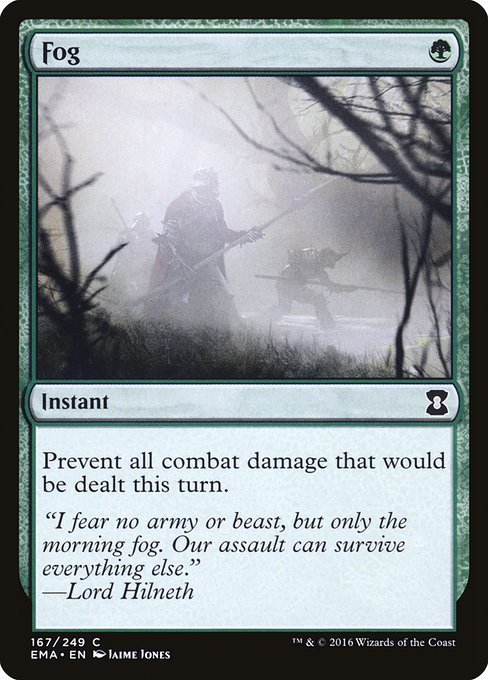
Image courtesy of Scryfall.com
Design Principles from Fog: Preventing Combat Damage on a Tap of Green
There’s a quiet elegance to Fog that mirrors the best lessons in card design: a single mana investment can reshape the entire tempo of a game. This evergreen instant from Eternal Masters isn’t flashy, but it’s deceptively powerful. For green—the color of growth, beefy creatures, and stompy inevitability—Fog represents a deliberate design choice: green can protect, stall, and stall again without necessarily swinging for the fences. 🧙🔥
Released in 2016 as part of Eternal Masters, Fog is a common rarity that nonetheless made a lasting impression on players who learned to value defense as a legitimate path to victory. The card’s text is simple: "Prevent all combat damage that would be dealt this turn." That one line codifies a design philosophy: the power of a timely shield can be as decisive as the most brutal combat trick. It’s green’s version of a defensive toolkit, and it arrives at a price point that invites experimentation in both casual and more serious formats. ⚔️🎨
From Concept to Card: What the Designers Targeted
Fog’s mana cost — {G} — is deliberately economical. It embodies green’s affinity for efficiency: one green mana, instant speed, a universal shield against the most common form of aggression on the battlefield. The effect is broad enough to affect multiple creatures and combat exchanges in a single moment, yet narrow enough to exclude noncombat damage or post-turn consequences. This clarity of scope is a design strength: players instantly grasp what it does, when to cast it, and what it cannot do. The result is a card that rewards precise timing and reads as a graceful puzzle rather than a brute force answer. 🧩💎
The flavor text adds another layer: "I fear no army or beast, but only the morning fog. Our assault can survive everything else."—Lord Hilneth. The lore aligns with the card’s function—Fog isn’t about overwhelming force; it’s about endurance, patience, and the suspense of what happens when you erase the threat of combat for a single turn. That mood—soft, relentless, inexorable—echoes in the art and the rules text alike, reinforcing that sometimes the most decisive moment is a single breath held between two beats of combat. This is design that whispers, not shouts. 🧙♀️🗡️
Green’s Unlikely Armor: The Language of Combat Prevention
Fog sits at an interesting crossroad in the language of the color pie. Green is often about big creatures, growth, and natural advantage in the long game; blue is the classic home of stoppage and counterplay, white for discipline and protection, and red for aggression. Fog carves out a niche where green can trade a little offensive tempo for crucial survivability. It’s not a flashy aura of invincibility; it’s a pragmatic, on-theme answer to swarming boards and tricky combat math. The design teaches an essential lesson: a well-placed, low-cost answer can shape the outcome of an entire turn—and sometimes of an entire game. 🧭⚔️
Art, Rarity, and Accessibility: Why This Card Endures
Jaime Jones’s illustration—subtle, misty, and evocative—captures the card’s mood without overshadowing its mechanics. The nonfoil and foil finishes both exist, but the card’s common rarity is what makes it a staple in budget-focused decks and in commander tables where every spell slot counts. The Eternal Masters reprint reinforced Fog’s status as a go-to option for players who want a dependable answer to combat pressure without breaking the bank. In terms of collector value, you’re looking at a card that’s widely accessible, with foil versions edging into the bargain bin of “nice-to-have” pretty quickly, yet still resonating with nostalgia and practical play. The data paints a familiar picture: a humble common that still makes room for memorable moments across formats like Modern, Legacy, and Commander. 🧙♂️💎
Practical Gameplay Takeaways: When Fog Shifts a Game
Imagine the board alive with attacking creatures, a well-timed Fog can swing momentum in a heartbeat. Your opponent commits to a sweep, and you blink in a green instant—no mana ramp, no setup, just a clean shield that denies the day’s damage. The payoff isn’t just life total; it’s the psychological edge: the opponent must rethink every swing and every block, knowing that even a hardened board can be paused by a single green burst. Fog works especially well in grindier archetypes that want to weather the early game and pivot to a late-game plan with minimal risk. It’s a lever you pull when you’re uncertain about the combat math or when you need a window to draw into a more definitive plan. 🧙♂️🎲
It also announces an important design principle: prevent-to-win doesn’t have to come in the form of a spell that exiles, destroys, or counters. Sometimes the simplest tool—a single-turn shield—teaches the most about game balance and pacing. This is a valuable lesson for new designers and seasoned players alike: keep the toolset lean, readable, and timely, and you empower players to find creativity within constraints. The card serves as a reminder that defense, too, can be a winning strategy when timed with care. 💡🎨
"Fog’s power is quiet and precise. It doesn’t steal the show; it reframes it." — A longtime MTG designer’s reflection on timeless green defense
Cross-Promo Note: A Moment of Comfort Between Games
As you reminisce about fog-drenched tactics, you might also be looking for a bit of comfort during long play sessions. If you’re nerding out over board states and spell lines, consider adding a little ergonomic relief to your desk setup—because great design deserves great support. Check out the Ergonomic Memory Foam Wrist Rest Mouse Pad Foot-Shaped for a touch of comfort during those marathon drafting and poker nights. It’s a lifestyle upgrade that pairs nicely with the patience and precision Fog encourages. 🧙🔥💎